nVidia GeForce GTX 285 Review
nVidia GeForce GTX 285
The fastest single GPU graphics card on the planet.
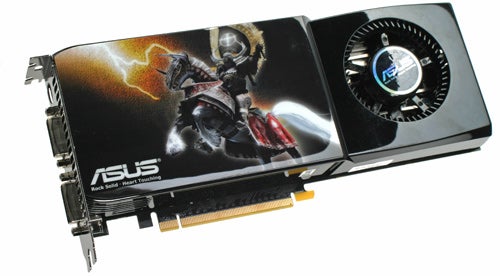
Verdict
Key Specifications
- Review Price: £350.00
The GeForce GTX 295, which uses two graphics chips working together in a single package, was nVidia’s first commercially available graphics card to use chips built on a 55nm manufacturing process. Previous cards from nVidia had all been built using a 65nm process so in relative terms they were more power hungry, ran hotter, and were more costly to produce. So, all told, this new manufacturing process was quite an exciting proposition.
However, the GTX 295 costs around £500 and is somewhat over powered for many of us – not to mention the whole ‘SLI on a card’ thing can still be somewhat temperamental. So, what we’ve really been waiting for is for nVidia to release cards based on chips built using the same smaller manufacturing process but with just one chip per card. In other words, we’ve been waiting for the card I’m looking at today, the GTX 285. 
As the name suggests, this is a direct follow up to the GTX 280 that launched last June and so bares a striking resemblance in many ways. For a start the chip still uses 240 stream processors split up into 10 stream processing clusters, 80 texture units, and 32 ROPs communicating with 1,024MB GDDR3 memory across a 512-bit interface. The card itself is also the same length and from certain angles looks identical. Looks can be deceiving though and there are certainly a notable number of changes.
First things first, the clock speeds have improved. The core clock has gone from 602MHz to 642MHz while the stream processor clock is now 1,476MHz, up from 1,296MHz, and the memory ticks along at 2,484MHz, an increase of 270MHz. All told these equate to an average increase of about 11 per cent, which isn’t exactly ground breaking but when you consider the quoted board power of the GTX 285 is actually 183W, as compared to the 236W of the GTX280, you can see it’s not just a performance benefit that you’ll get from buying one of these cards. 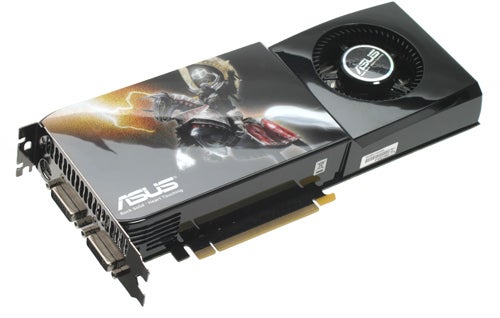
The board design has also changed quite considerably though outwardly these changes are at best subtle. In line with the reduction in power consumption, this card now only requires two six-pin PCI-Express power connectors rather than the six- and eight-pin connectors needed by the GTX 280. The power regulation circuitry has also been tweaked, particularly with a mind to reducing the peculiar whistling noises that plagued the GTX 280. This occurred only when the card was used with certain power supplies (actually most, in our experience) and at certain load levels (primarily just when turning the PC on) and were a result of electrical resonance between the card and power supply, creating a high-pitched whistling noise. According to some reports these fixes haven’t fully resolved the issue but at least on the two power supplies we’ve tested it on, the problem has disappeared.
Other changes to the board include the memory chips. Whereas on the GTX 280 the chips were mounted both on the back and front of the card (hence the protective backing on that card) all the chips are now on the front of the GTX 285. This means they are covered by the active cooler that also cools the main GPU chip, which could potentially lead to better cooling and better overclocking of the memory. It does mean we lose the protective backing though. 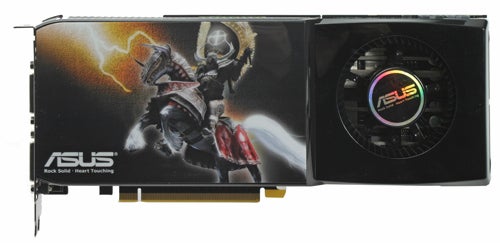
One thing that hasn’t changed is nVidia’s display controller which still doesn’t natively support DisplayPort so board partners will need to add their own DisplayPort controller chips to enable this connection. What you do get, though, is two dual-link DVI sockets and an analogue video output that supports S-Video, composite, and component outputs either natively or with the help of included dongles. Likewise, HDMI is supported via a DVI-to-HDMI dongle and there’s an audio connection next to the power sockets to enable audio pass-through.
One final point about the card’s physical design is its inclusion of the obligatory SLI connectors that appear in their usual location along the top edge of the PCB. The card can be used in dual- or triple- SLI configurations, both of which are scenarios we hope to test soon. For now, though, we’ll be doing just single card testing.
The review sample we were provided with is made by Asus and is actually overclocked straight out of the box. This meant we had to use nVidia’s overclocking tools to reduce the clock speeds to that of a normal card, as well as test it at the card’s factory speeds. Aside from these overclocking changes, this Asus card is just like any other GTX 285 and can be considered a reference model.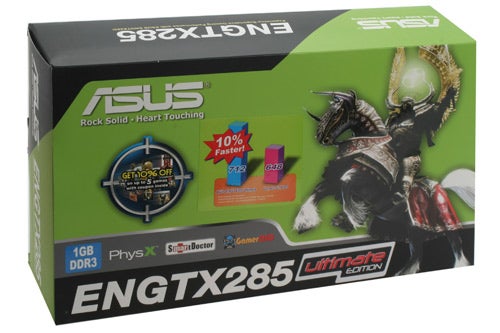
In the box you get a rather crummy padded leather mousemat, dongles for DVI-to-HDMI and DVI-to-VGA, a component video adapter for the analogue video output, a two-Molex to six-pin PCI-Express power adapter, and a cable for the internal audio pass through. 
As well as having to underclock this particular card we also had to contend with a brand new test bed for our graphics testing, which explains the reduced number of games tested. We’ve moved from an Intel Core 2 Quad QX9770 based system to one that uses Intel’s flagship Core i7 processor, the 965 Extreme Edition. We’ve also changed from 32-bit Windows Vista to 64-bit windows Vista, a move that was essential considering the size of modern games. Indeed, subjectively, this made a huge difference, as it greatly reduced the number of times a game would need to access the hard drive during testing and essentially eliminated the pauses this would cause.
”’Old Test System”’
* Intel Core 2 Quad QX9770
* Asus P5E3
* 2GB Corsair TWIN3X2048-1333C9 DDR3
* 150GB Western Digital Raptor
* Microsoft Windows Vista Home Premium 32-bit
”’New Test System”’
* Intel Core i7 965 Extreme Edition
* Asus P6T motherboard
* 3 x 1GB Qimonda IMSH1GU03A1F1C-10F PC3-8500 DDR3 RAM
* 150GB Western Digital Raptor
* Microsoft Windows Vista Home Premium 64-bit
”’Cards Tested”’
* Asus ENGTX285 Ultimate Edition
* nVidia GeForce GTX 285
* nVidia GeForce GTX 295
* nVidia GeForce GTX 280
* nVidia GeForce GTX 260
* ATI HD 4870 X2
* ATI HD 4870
”’Drivers”’
* nVidia cards – 182.08
* ATI cards – Catalyst 9.2
”’Games Tested”’
* Crysis
* Call of Duty 4
* Counter-Strike: Source
While it hasn’t been a huge commercial success and its gameplay is far from revolutionary, the graphical fidelity of Crysis is still second to none and as such it’s still the ultimate test for a graphics card. With masses of dynamic foliage, rolling mountain ranges, bright blue seas, and big explosions, this game has all the eye-candy you could wish for and then some.
We test using the 64-bit version of the game patched to version 1.1 and running in DirectX 10 mode. We use a custom timedemo that’s taken from the first moments at the start of the game, wandering around the beach. Surprisingly, considering its claustrophobic setting and graphically rich environment, we find that any frame rate above 30fps is about sufficient to play this game. All in-game settings are set to high for our test runs and we test with both 0xAA and 4xAA.
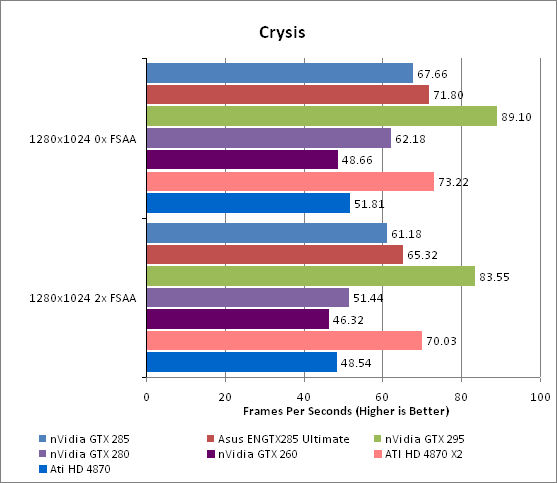
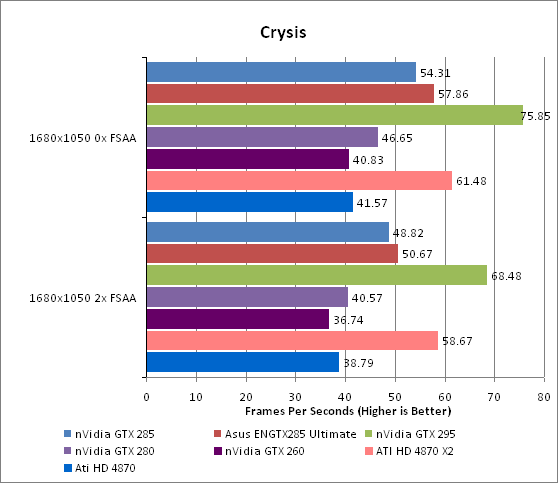
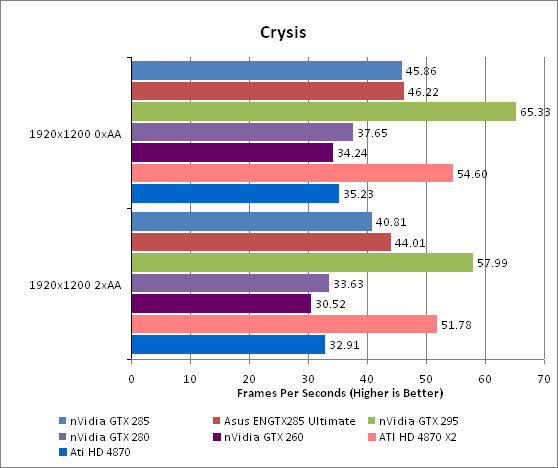
Things are off to a good start here with the GTX 285 (and its overclocked Asus version) comfortably beating its predecessor and all other single-GPU cards. It’s still a fair way off the pace of the dual-GPU cards but is impressive stuff nonetheless.
Call of Duty 4 has to be one of our favourite games of 2007. It brought the Call of Duty brand bang up to date and proved that first person shooters didn’t need to have the best graphics, or the longest game time. It was just eight hours of pure adrenaline rush that constantly kept you on edge.
We test using the 32-bit version of the game patched to version 1.4. FRAPS is used to record frame rates while we manually walk through a short section of the second level of the game. We find a frame rate of 30fps is quite sufficient because, although the atmosphere is intense, the gameplay is less so – it doesn’t hang on quick reactions and high-speed movement. All in-game settings are set to their maximum and we test with 0xAA and 4xAF.
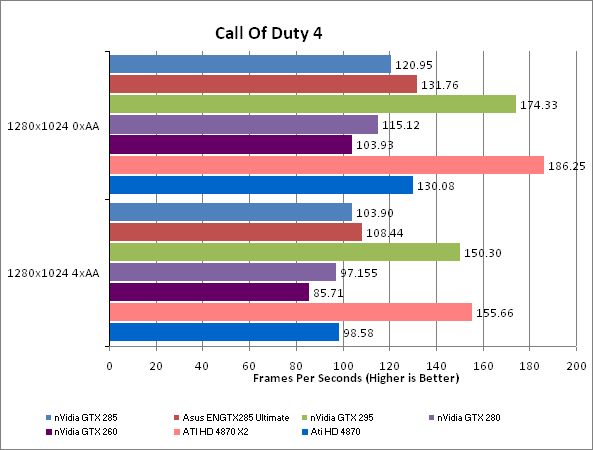
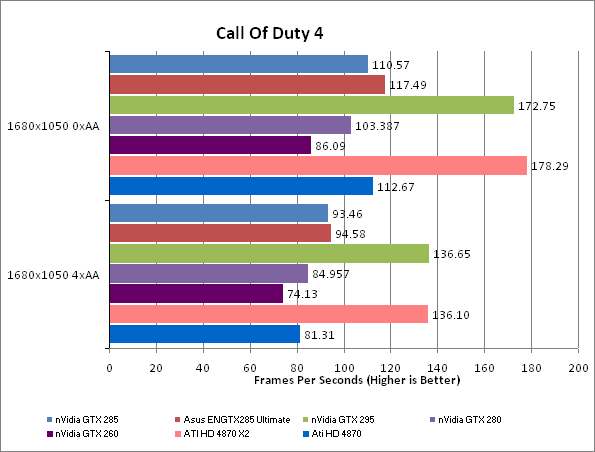
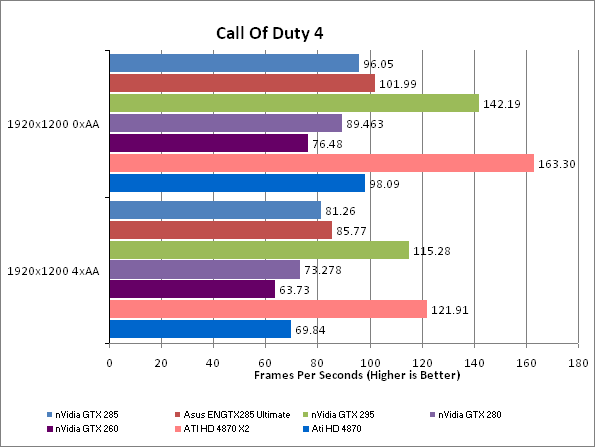
All the cards on test today would make for a good option when playing this game but the GTX 285 again proves it’s the fastest single-GPU card available. What is interesting, though, is how good the HD 4870 X2 is. It’s only 35 per cent more expensive but is delivering a 60 per cent performance improvement over the GTX 285.
What can we say about Counter-Strike: Source that hasn’t already been said before? It is quite simply the benchmark for team-based online shooters and, five years after its release, it’s still one of the most popular games in its genre. It focuses on small environments and incredibly intensive small-scale battles with one-shot kills the order of the day. If you want to test all elements of your first person shooter skills in one go, this is the game to do it.
We test using the 32-bit version of the game using a custom timedemo taken during a game against bots on the cs_militia map. This has a large amount of foliage and is generally one of the most graphically intensive maps available. We find a frame rate of at least 60fps is required for serious gaming as this game relies massively on quick, accurate reactions that simply can’t be compromised by dropped frames. All in-game settings are set to their maximum and we test with 0xAA 0xAF, 2xAA 4xAF, and 4xAA 8xAA.
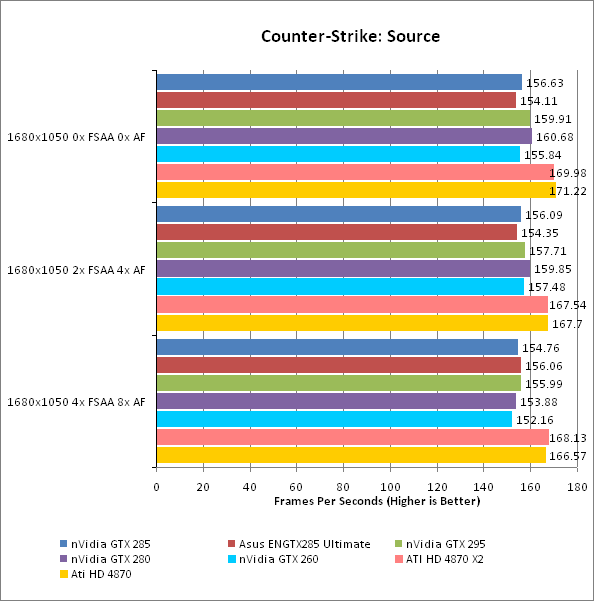
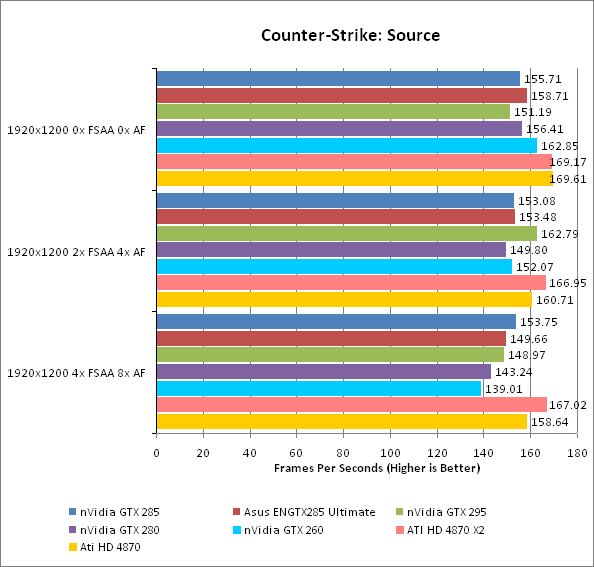
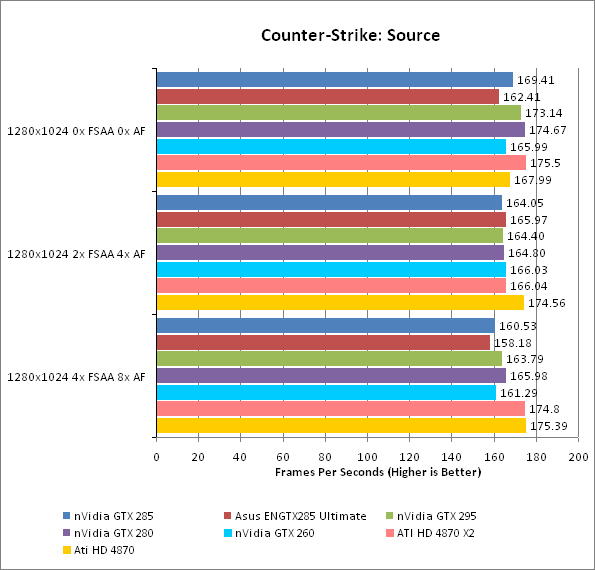
In truth, this game just isn’t a challenge for cards of this calibre and there is simply nothing of note to be taken from these results. That said, it’s interesting as a frame of reference to see how cards have improved over a longer period of time.
”’Power Consumption”’
One of the key advantages of shrinking your product’s manufacturing process is theoretically getting the same performance while using less power, and this is a fact that’s been borne out with the GTX 285. The difference between this card and its predecessor isn’t perhaps quite as dramatic as one might first hope but remember the GTX 285 is also clocked higher, which increases power consumption. 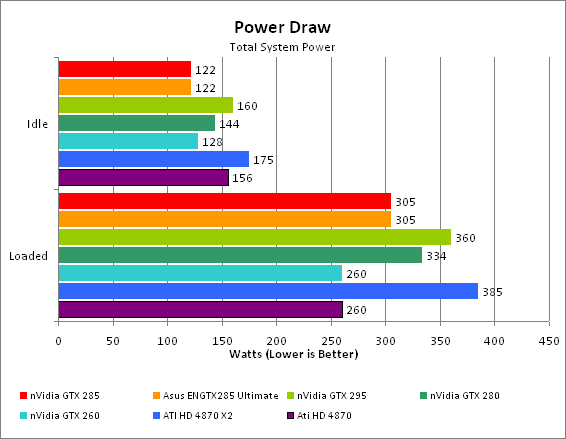
As compared with the competition from ATI, it’s six of one and half a dozen of the other. The GTX 285 draws significantly less power than the HD 4870 when idling but then considerably more when under load. We’d be inclined to hand the victory to nVidia’s latest, though, as that high load figure also accompanies a reasonably significant performance advantage as well. 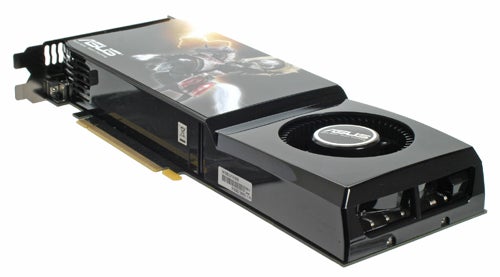
”’Final Thoughts”’
As well as impressing us with its performance and power consumption, the GTX 285 has one final trick up its sleeve. It’s cooler is surprisingly quiet, particularly when idling, and is markedly less intrusive all round than those employed by ATI’s top cards.
However, things are less rosy when we come to look at value. There’s simply no denying £300 odd (or closer to £350 for the overclocked card we’ve tested) is a lot to spend on a graphics card, especially given that you can get overclocked ATI HD 4870s for under £200. That said, the GTX 285 does at least occupy a unique territory. The ATI Radeon HD 4870 X2 and nVidia GeForce GTX 295 are both way ahead in terms of performance but their dual-chip design can still be temperamental and they cost £400-£500, so by being the fastest single-chip graphics card and ‘only’ costing £300, the GTX 285 will appeal to many. Overall, though, we still feel it’s a little overpriced, regardless of its unique position.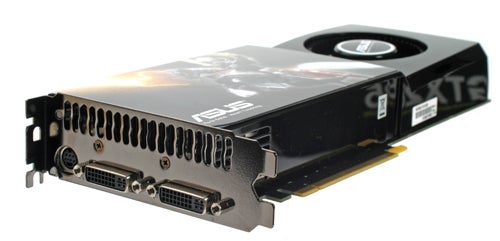
”’Verdict”’
The nVidia GeForce GTX 285 is the fastest single-GPU graphics card on the market, which is impressive enough in itself. However, factor in its surprisingly quiet HSF and lower power consumption than its predecessor and we start to get very excited indeed. Unfortunately, its high price prevents the GTX 285 from getting an outright recommended award but it’s definitely one to consider.
Trusted Score
Score in detail
-
Value 6
-
Features 7
-
Performance 9

